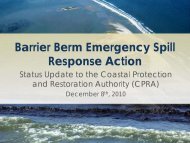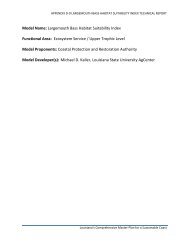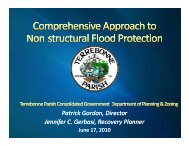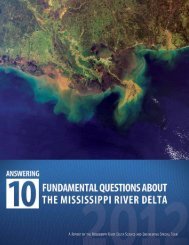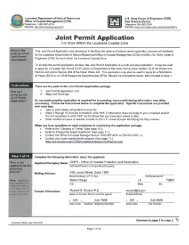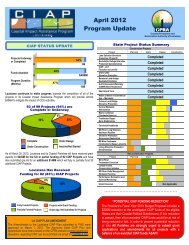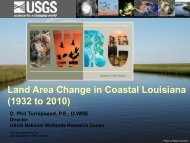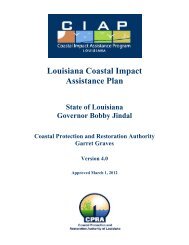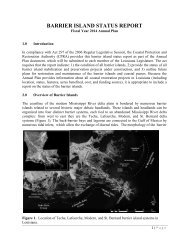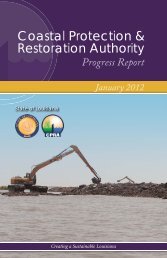Appendix G5a â Public Comments - Coastal Protection and ...
Appendix G5a â Public Comments - Coastal Protection and ...
Appendix G5a â Public Comments - Coastal Protection and ...
Create successful ePaper yourself
Turn your PDF publications into a flip-book with our unique Google optimized e-Paper software.
Print Preview : <strong>Public</strong> Comment Form : Bulk Printhttp://www.coastalmasterplan.louisiana.gov/wp-content/plugins/gravityforms/print-entry.p...Page 3 of 32/24/2012a) Operational Safety: Any structures built in a waterway increase the likelihood of vessel casualties, which obviouslywould bring a negative impact to the restoration/protection benefits of the structure. The State should view the GIWW<strong>and</strong> Mississippi River in the same way it views Interstate 10. Building a structure across a major commercial/industrialtransportation artery invites a level of risk that is not present for other restoration or protection features. It is not inanyone’s interest to see a vessel casualty involving a critical flood control structure, or for vessels to becomestr<strong>and</strong>ed along the banks during an unplanned floodgate closure.b) Construction Delay: The construction <strong>and</strong> maintenance of nation's marine infrastructure on federal waterways isthe exclusive domain of the US Army Corps of Engineers. Currently, there are over 20 lock <strong>and</strong> dam projects (eithernew construction or major rehab) on the Corps' project backlog, almost all of which are well over budget <strong>and</strong> offschedule.To give just one example, the Corps recently announced that Olmsted Lock <strong>and</strong> Dam project (authorized in1988 with an expected 7 year construction period) is expected to cost $1.3 Billion more than originally estimated, <strong>and</strong>take 25 years longer to complete than originally planned. This additional cost overrun will likely consume every dollarof the Inl<strong>and</strong> Waterways Trust Fund (the mechanism for funding major lock projects). Given the above, it is extremelyunlikely that a new lock could be authorized, funded, <strong>and</strong> constructed on the GIWW in the foreseeable future until thecurrent backlog of projects is addressed.c) Unplanned Costs: One aspect of the Master Plan that needs further study is the cost to operate <strong>and</strong> maintain newstructures. Even assuming the timely construction of new locks or gates, if they are viewed as 'flood protection'projects <strong>and</strong> not 'navigation' projects, the Corps will not retain the O+M responsibility for the structures. This situationexists today for the West Closure Complex <strong>and</strong> the IHNC Floodgate near New Orleans. Efforts are underway toensure that the Corps retains O+M responsibility for these structures given their navigation function <strong>and</strong> location on akey federal waterway, but because of the authorization language for these projects, it is possible that criticalresources (both funds <strong>and</strong> personnel) will be diverted from the local/regional levee authorities to operate thesestructures on a 24/7/365 basis. Adding more locks or gates on the GIWW under the auspices of the State's MasterPlan will undoubtedly lead to similar problems.To summarize items (b) <strong>and</strong> (c), if the Master Plan calls for additional “locks,” those locks are unlikely to ever be built.If the Master Plan calls for additional “floodgates,” the State may be forced to dedicate major resources to fill theCorps’ traditional O+M role to ensure safe operations <strong>and</strong> to prevent disruptions to America’s third busiest waterway.The State's funds <strong>and</strong> personnel would be much better utilized elsewhere than on trying to operate <strong>and</strong> maintainlocks or gates across the GIWW.ConclusionLike many members of the Louisiana maritime industry, Canal Barge Company underst<strong>and</strong>s the importance ofrestoring our coast <strong>and</strong> protecting our citizens from storm flooding. If coastal erosion continues unabated, we mayvery well lose the very waterways upon which our business operates, <strong>and</strong> if our communities are not protected, wemay lose our workforce, <strong>and</strong> our own homes. We thank the State for the opportunity to comment on the Master Plan,<strong>and</strong> hope that our comments will provide useful, ‘real-world’ feedback that will help improve the final version of theMaster Plan.Regards,Spencer MurphyVice President - Canal Barge Company, Inc.Canal Barge Company, Inc.



